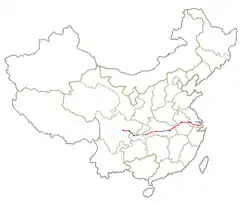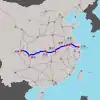Shanghai–Wuhan–Chengdu passenger railway
Shanghai–Wuhan–Chengdu passenger railway (Chinese: 沪汉蓉快速客运通道), is a fully completed high-speed railway corridor operated by China Railway High-speed. The Chinese name of the railway line, Huhanrong, is a combination of the abbreviations for Shanghai (沪, Hù), Wuhan (汉, Hàn), and Chengdu (蓉, Róng), three major cities along the line.
| Shanghai–Wuhan–Chengdu passenger railway 沪汉蓉快速客运通道 | |||||||||||||||||||||||||||||||||||||||||||||||||||||||||||||||||||||||||||||||||||||||||||||||||||||||||||||||||||||||||||||||||||||||||||||||||||||||||||||||||||||||||||||||||||||||||||||||||||||||||||||||||||||||||||||||||||||||||||||||||||||||||||||||||||||||||||||||||||||||||||||||||||||||||||||||||||||||||||||||||||||||||||||||||||||||||||||||||||||||||||||||||||||||||||||||||||||||||||||||||||||||||||||||||||||||||||||||||||||||||||||||||||||||||||||||||||||||||||||||||||||||||||||||||||||||||||||||||||||||||||||||||||||||||||||||||||||||||||||||||||||||||||||||||||||||||||||||||
|---|---|---|---|---|---|---|---|---|---|---|---|---|---|---|---|---|---|---|---|---|---|---|---|---|---|---|---|---|---|---|---|---|---|---|---|---|---|---|---|---|---|---|---|---|---|---|---|---|---|---|---|---|---|---|---|---|---|---|---|---|---|---|---|---|---|---|---|---|---|---|---|---|---|---|---|---|---|---|---|---|---|---|---|---|---|---|---|---|---|---|---|---|---|---|---|---|---|---|---|---|---|---|---|---|---|---|---|---|---|---|---|---|---|---|---|---|---|---|---|---|---|---|---|---|---|---|---|---|---|---|---|---|---|---|---|---|---|---|---|---|---|---|---|---|---|---|---|---|---|---|---|---|---|---|---|---|---|---|---|---|---|---|---|---|---|---|---|---|---|---|---|---|---|---|---|---|---|---|---|---|---|---|---|---|---|---|---|---|---|---|---|---|---|---|---|---|---|---|---|---|---|---|---|---|---|---|---|---|---|---|---|---|---|---|---|---|---|---|---|---|---|---|---|---|---|---|---|---|---|---|---|---|---|---|---|---|---|---|---|---|---|---|---|---|---|---|---|---|---|---|---|---|---|---|---|---|---|---|---|---|---|---|---|---|---|---|---|---|---|---|---|---|---|---|---|---|---|---|---|---|---|---|---|---|---|---|---|---|---|---|---|---|---|---|---|---|---|---|---|---|---|---|---|---|---|---|---|---|---|---|---|---|---|---|---|---|---|---|---|---|---|---|---|---|---|---|---|---|---|---|---|---|---|---|---|---|---|---|---|---|---|---|---|---|---|---|---|---|---|---|---|---|---|---|---|---|---|---|---|---|---|---|---|---|---|---|---|---|---|---|---|---|---|---|---|---|---|---|---|---|---|---|---|---|---|---|---|---|---|---|---|---|---|---|---|---|---|---|---|---|---|---|---|---|---|---|---|---|---|---|---|---|---|---|---|---|---|---|---|---|---|---|---|---|---|---|---|---|---|---|---|---|---|---|---|---|---|---|---|---|---|---|---|---|---|---|---|---|---|---|---|---|---|---|---|---|---|---|---|---|---|---|---|---|---|---|---|---|---|---|---|---|---|---|---|---|---|---|---|---|---|---|---|---|---|---|---|---|---|---|---|---|---|---|---|---|---|---|---|---|---|---|---|---|---|---|---|---|---|---|---|---|---|---|---|---|---|---|---|---|---|---|---|---|---|---|---|---|---|---|---|---|---|---|---|---|---|---|---|---|---|---|---|---|---|---|---|---|---|---|---|---|---|---|---|---|---|---|---|---|---|---|---|---|---|---|---|---|---|---|---|---|---|---|---|---|---|---|---|---|---|---|---|---|---|---|---|---|---|---|---|---|---|
 | |||||||||||||||||||||||||||||||||||||||||||||||||||||||||||||||||||||||||||||||||||||||||||||||||||||||||||||||||||||||||||||||||||||||||||||||||||||||||||||||||||||||||||||||||||||||||||||||||||||||||||||||||||||||||||||||||||||||||||||||||||||||||||||||||||||||||||||||||||||||||||||||||||||||||||||||||||||||||||||||||||||||||||||||||||||||||||||||||||||||||||||||||||||||||||||||||||||||||||||||||||||||||||||||||||||||||||||||||||||||||||||||||||||||||||||||||||||||||||||||||||||||||||||||||||||||||||||||||||||||||||||||||||||||||||||||||||||||||||||||||||||||||||||||||||||||||||||||||
| Overview | |||||||||||||||||||||||||||||||||||||||||||||||||||||||||||||||||||||||||||||||||||||||||||||||||||||||||||||||||||||||||||||||||||||||||||||||||||||||||||||||||||||||||||||||||||||||||||||||||||||||||||||||||||||||||||||||||||||||||||||||||||||||||||||||||||||||||||||||||||||||||||||||||||||||||||||||||||||||||||||||||||||||||||||||||||||||||||||||||||||||||||||||||||||||||||||||||||||||||||||||||||||||||||||||||||||||||||||||||||||||||||||||||||||||||||||||||||||||||||||||||||||||||||||||||||||||||||||||||||||||||||||||||||||||||||||||||||||||||||||||||||||||||||||||||||||||||||||||||
| Owner | China Railway | ||||||||||||||||||||||||||||||||||||||||||||||||||||||||||||||||||||||||||||||||||||||||||||||||||||||||||||||||||||||||||||||||||||||||||||||||||||||||||||||||||||||||||||||||||||||||||||||||||||||||||||||||||||||||||||||||||||||||||||||||||||||||||||||||||||||||||||||||||||||||||||||||||||||||||||||||||||||||||||||||||||||||||||||||||||||||||||||||||||||||||||||||||||||||||||||||||||||||||||||||||||||||||||||||||||||||||||||||||||||||||||||||||||||||||||||||||||||||||||||||||||||||||||||||||||||||||||||||||||||||||||||||||||||||||||||||||||||||||||||||||||||||||||||||||||||||||||||||
| Locale | Shanghai, Jiangsu, Anhui, Hubei, Chongqing, Sichuan | ||||||||||||||||||||||||||||||||||||||||||||||||||||||||||||||||||||||||||||||||||||||||||||||||||||||||||||||||||||||||||||||||||||||||||||||||||||||||||||||||||||||||||||||||||||||||||||||||||||||||||||||||||||||||||||||||||||||||||||||||||||||||||||||||||||||||||||||||||||||||||||||||||||||||||||||||||||||||||||||||||||||||||||||||||||||||||||||||||||||||||||||||||||||||||||||||||||||||||||||||||||||||||||||||||||||||||||||||||||||||||||||||||||||||||||||||||||||||||||||||||||||||||||||||||||||||||||||||||||||||||||||||||||||||||||||||||||||||||||||||||||||||||||||||||||||||||||||||
| Termini | Shanghai Hongqiao Shanghai Chengdu East Chengdu | ||||||||||||||||||||||||||||||||||||||||||||||||||||||||||||||||||||||||||||||||||||||||||||||||||||||||||||||||||||||||||||||||||||||||||||||||||||||||||||||||||||||||||||||||||||||||||||||||||||||||||||||||||||||||||||||||||||||||||||||||||||||||||||||||||||||||||||||||||||||||||||||||||||||||||||||||||||||||||||||||||||||||||||||||||||||||||||||||||||||||||||||||||||||||||||||||||||||||||||||||||||||||||||||||||||||||||||||||||||||||||||||||||||||||||||||||||||||||||||||||||||||||||||||||||||||||||||||||||||||||||||||||||||||||||||||||||||||||||||||||||||||||||||||||||||||||||||||||
| Service | |||||||||||||||||||||||||||||||||||||||||||||||||||||||||||||||||||||||||||||||||||||||||||||||||||||||||||||||||||||||||||||||||||||||||||||||||||||||||||||||||||||||||||||||||||||||||||||||||||||||||||||||||||||||||||||||||||||||||||||||||||||||||||||||||||||||||||||||||||||||||||||||||||||||||||||||||||||||||||||||||||||||||||||||||||||||||||||||||||||||||||||||||||||||||||||||||||||||||||||||||||||||||||||||||||||||||||||||||||||||||||||||||||||||||||||||||||||||||||||||||||||||||||||||||||||||||||||||||||||||||||||||||||||||||||||||||||||||||||||||||||||||||||||||||||||||||||||||||
| Type | High-speed rail, Heavy rail | ||||||||||||||||||||||||||||||||||||||||||||||||||||||||||||||||||||||||||||||||||||||||||||||||||||||||||||||||||||||||||||||||||||||||||||||||||||||||||||||||||||||||||||||||||||||||||||||||||||||||||||||||||||||||||||||||||||||||||||||||||||||||||||||||||||||||||||||||||||||||||||||||||||||||||||||||||||||||||||||||||||||||||||||||||||||||||||||||||||||||||||||||||||||||||||||||||||||||||||||||||||||||||||||||||||||||||||||||||||||||||||||||||||||||||||||||||||||||||||||||||||||||||||||||||||||||||||||||||||||||||||||||||||||||||||||||||||||||||||||||||||||||||||||||||||||||||||||||
| Operator(s) | China Railway High-speed | ||||||||||||||||||||||||||||||||||||||||||||||||||||||||||||||||||||||||||||||||||||||||||||||||||||||||||||||||||||||||||||||||||||||||||||||||||||||||||||||||||||||||||||||||||||||||||||||||||||||||||||||||||||||||||||||||||||||||||||||||||||||||||||||||||||||||||||||||||||||||||||||||||||||||||||||||||||||||||||||||||||||||||||||||||||||||||||||||||||||||||||||||||||||||||||||||||||||||||||||||||||||||||||||||||||||||||||||||||||||||||||||||||||||||||||||||||||||||||||||||||||||||||||||||||||||||||||||||||||||||||||||||||||||||||||||||||||||||||||||||||||||||||||||||||||||||||||||||
| History | |||||||||||||||||||||||||||||||||||||||||||||||||||||||||||||||||||||||||||||||||||||||||||||||||||||||||||||||||||||||||||||||||||||||||||||||||||||||||||||||||||||||||||||||||||||||||||||||||||||||||||||||||||||||||||||||||||||||||||||||||||||||||||||||||||||||||||||||||||||||||||||||||||||||||||||||||||||||||||||||||||||||||||||||||||||||||||||||||||||||||||||||||||||||||||||||||||||||||||||||||||||||||||||||||||||||||||||||||||||||||||||||||||||||||||||||||||||||||||||||||||||||||||||||||||||||||||||||||||||||||||||||||||||||||||||||||||||||||||||||||||||||||||||||||||||||||||||||||
| Opened | July 1, 2014 | ||||||||||||||||||||||||||||||||||||||||||||||||||||||||||||||||||||||||||||||||||||||||||||||||||||||||||||||||||||||||||||||||||||||||||||||||||||||||||||||||||||||||||||||||||||||||||||||||||||||||||||||||||||||||||||||||||||||||||||||||||||||||||||||||||||||||||||||||||||||||||||||||||||||||||||||||||||||||||||||||||||||||||||||||||||||||||||||||||||||||||||||||||||||||||||||||||||||||||||||||||||||||||||||||||||||||||||||||||||||||||||||||||||||||||||||||||||||||||||||||||||||||||||||||||||||||||||||||||||||||||||||||||||||||||||||||||||||||||||||||||||||||||||||||||||||||||||||||
| Technical | |||||||||||||||||||||||||||||||||||||||||||||||||||||||||||||||||||||||||||||||||||||||||||||||||||||||||||||||||||||||||||||||||||||||||||||||||||||||||||||||||||||||||||||||||||||||||||||||||||||||||||||||||||||||||||||||||||||||||||||||||||||||||||||||||||||||||||||||||||||||||||||||||||||||||||||||||||||||||||||||||||||||||||||||||||||||||||||||||||||||||||||||||||||||||||||||||||||||||||||||||||||||||||||||||||||||||||||||||||||||||||||||||||||||||||||||||||||||||||||||||||||||||||||||||||||||||||||||||||||||||||||||||||||||||||||||||||||||||||||||||||||||||||||||||||||||||||||||||
| Line length | 2078 km | ||||||||||||||||||||||||||||||||||||||||||||||||||||||||||||||||||||||||||||||||||||||||||||||||||||||||||||||||||||||||||||||||||||||||||||||||||||||||||||||||||||||||||||||||||||||||||||||||||||||||||||||||||||||||||||||||||||||||||||||||||||||||||||||||||||||||||||||||||||||||||||||||||||||||||||||||||||||||||||||||||||||||||||||||||||||||||||||||||||||||||||||||||||||||||||||||||||||||||||||||||||||||||||||||||||||||||||||||||||||||||||||||||||||||||||||||||||||||||||||||||||||||||||||||||||||||||||||||||||||||||||||||||||||||||||||||||||||||||||||||||||||||||||||||||||||||||||||||
| Track gauge | 1,435 mm (4 ft 8 1⁄2 in) | ||||||||||||||||||||||||||||||||||||||||||||||||||||||||||||||||||||||||||||||||||||||||||||||||||||||||||||||||||||||||||||||||||||||||||||||||||||||||||||||||||||||||||||||||||||||||||||||||||||||||||||||||||||||||||||||||||||||||||||||||||||||||||||||||||||||||||||||||||||||||||||||||||||||||||||||||||||||||||||||||||||||||||||||||||||||||||||||||||||||||||||||||||||||||||||||||||||||||||||||||||||||||||||||||||||||||||||||||||||||||||||||||||||||||||||||||||||||||||||||||||||||||||||||||||||||||||||||||||||||||||||||||||||||||||||||||||||||||||||||||||||||||||||||||||||||||||||||||
| Operating speed | 350–200 km/h (220–120 mph) | ||||||||||||||||||||||||||||||||||||||||||||||||||||||||||||||||||||||||||||||||||||||||||||||||||||||||||||||||||||||||||||||||||||||||||||||||||||||||||||||||||||||||||||||||||||||||||||||||||||||||||||||||||||||||||||||||||||||||||||||||||||||||||||||||||||||||||||||||||||||||||||||||||||||||||||||||||||||||||||||||||||||||||||||||||||||||||||||||||||||||||||||||||||||||||||||||||||||||||||||||||||||||||||||||||||||||||||||||||||||||||||||||||||||||||||||||||||||||||||||||||||||||||||||||||||||||||||||||||||||||||||||||||||||||||||||||||||||||||||||||||||||||||||||||||||||||||||||||
| |||||||||||||||||||||||||||||||||||||||||||||||||||||||||||||||||||||||||||||||||||||||||||||||||||||||||||||||||||||||||||||||||||||||||||||||||||||||||||||||||||||||||||||||||||||||||||||||||||||||||||||||||||||||||||||||||||||||||||||||||||||||||||||||||||||||||||||||||||||||||||||||||||||||||||||||||||||||||||||||||||||||||||||||||||||||||||||||||||||||||||||||||||||||||||||||||||||||||||||||||||||||||||||||||||||||||||||||||||||||||||||||||||||||||||||||||||||||||||||||||||||||||||||||||||||||||||||||||||||||||||||||||||||||||||||||||||||||||||||||||||||||||||||||||||||||||||||||||
| Shanghai–Wuhan–Chengdu passenger railway | |||||||
|---|---|---|---|---|---|---|---|
| Simplified Chinese | 沪汉蓉快速客运通道 | ||||||
| Traditional Chinese | 滬漢蓉快速客運通道 | ||||||
| |||||||
The Shanghai–Wuhan–Chengdu railway is one of the four east–west high-speed rail corridors outlined in China's national high-speed rail plan. From east to west, it will connect the major cities of Shanghai (a provincial-level municipality), Nanjing (the capital of Jiangsu), Hefei (the capital of Anhui), Wuhan (the capital of Hubei), Chongqing (a province-level municipality), and Chengdu (the capital of Sichuan). The total population of the four provinces and two municipalities served by this rail line is over 320 million (as of 2008).[1]
Despite its name, the line is actually a medium-speed railway designed to run at a maximum speed of 200 km/h (120 mph) between Nanjing and Chongqing. The newer Yangtze River passageway, running parallel to it at 350 km/h (220 mph), is being planned to manage the increasing passenger traffic.
Components
All sections are now operational.
Operational lines are marked with green background.
| Section | Description | Designed speed (km/h) |
Length (km) |
Construction start date |
Open date |
|---|---|---|---|---|---|
Shanghai–Wuhan–Chengdu passenger railway |
PDL through the Yangtze Valley consisting the Shanghai–Nanjing section of the Beijing–Shanghai line, and 7 mixed-use HSR segments connecting Nanjing, Hefei, Wuhan, Yichang, Lichuan, Chongqing, Suining & Chengdu. | 350-200 | 2078 | 2003-12-01 | 2014-07-01 |
| Shanghai–Nanjing section | Shares tracks with the Beijing–Shanghai High-Speed Railway and Shanghai–Nanjing Intercity Railway. | 350 | 301 | 2008-04-18 2008-07-01 |
2010-07-01 2011-06-30 |
| Nanjing–Hefei section (Hefei–Nanjing railway) |
Mixed passenger & freight HSR connecting Nanjing & Hefei | 250 | 166 | 2005-06-11 | 2008-04-18 |
| Hefei–Wuhan section (Hefei–Wuhan railway) |
Mixed passenger & freight HSR connecting Hefei & Wuhan | 250 | 351 | 2005-08-01 | 2008-12-31 |
| (Wuhan)Hankou–Yichang section (Hankou–Yichang railway) |
Mixed passenger & freight HSR connecting Wuhan & Yichang | 200 | 293 | 2008-09-17 | 2012-07-01 |
| Yichang–Lichuan section (Yichang–Wanzhou railway) |
Mixed passenger & freight HSR connecting Yichang & Lichuan[2] | 200 | 377 | 2003-12-01 | 2014-07-01 |
| Lichuan–Chongqing section (Chongqing–Lichuan railway) |
Mixed passenger & freight HSR connecting Lichuan & Chongqing | 200 | 264 | 2008-12-29 | 2013-12-28 |
| Chongqing–Suining section (Suining–Chongqing railway) |
Mixed passenger & freight HSR connecting Chongqing & Suining | 200 | 132 | 2009-01-18 | 2009-9-29 |
| Suining–Chengdu railway | Mixed passenger & freight HSR connecting Suining & Chengdu. | 200 | 148 | 2005-05 | 2009-06-30 |
Shanghai–Nanjing
From Shanghai to Nanjing, the line uses the Beijing–Shanghai high-speed railway and the Shanghai–Nanjing intercity railway both lines have the designed speed of 350 km/h (220 mph).
Nanjing to Hefei
From Nanjing to Hefei, the line is called the Hefei–Nanjing railway. The Hefei–Nanjing Railway is shared with the Nanjing–Xi'an railway. It has a designed speed of 250 km/h (160 mph). At Hefei, a connection is available to the Hefei–Bengbu high-speed railway, which is a branch line of the Beijing–Shanghai high-speed railway, although both Shanghai-Chengdu Main Line and Hefei-Bengbu branch has now mostly used Hefei South Railway Station instead.
Hefei to Wuhan
From Hefei to Wuhan, the line is called the Hefei–Wuhan railway, with a designed speed of 250 km/h (160 mph). At Wuhan, a connection is available to the Beijing–Guangzhou–Shenzhen–Hong Kong high-speed railway, an important north-south railway line from Beijing to Guangzhou and Kowloon, Hong Kong, although Hankou Railway Station instead of Wuhan Station is on the main line.
Wuhan to Yichang
From Wuhan to Yichang, the line is called the Wuhan–Yichang railway.
Yichang–Wanzhou railway
The Yichang–Wanzhou railway connects the cities of Yichang, Lichuan, and Wanzhou. The Shanghai–Wuhan–Chengdu passenger-dedicated line only uses the Yichang to Lichuan portion of the Yichang–Wanzhou Railway. (The actual splitting point of Yichang-Wanzhou and Chongqing-Lichuan railways is Liangwu railway station)
Due to harsh terrains some part of this section has a maximum speed of 140-160km/h, which is the lowest in China's high-speed network.
Chongqing–Lichuan railway
At Lichuan, the Chongqing–Lichuan railway connects it with the city of Chongqing.
Suining–Chongqing railway
The Suining–Chongqing railway connects the cities of Chongqing and Suining. Its designed operating speed is 200 km/h (120 mph).
Suining–Chengdu railway
The Suining–Chengdu railway connects the cities of Suining and Chengdu. Its designed operating speed is 200 km/h (120 mph). Until 2009, this line was considered to form part of the Dazhou–Chengdu railway.
Chengdu–Chongqing intercity railway
The newly constructed Chengdu–Chongqing intercity railway links Chengdu and Chongqing directly using a southern route (via Neijiang). This line is operated at 300-310km/h which is much faster than the above two lines.
Routing
While some sections of the line parallels existing conventional railways, others have been constructed on a new separate alignment, done to avoid difficult terrain, provide a more direct route or to serve areas where no rail service existed before. In particular, until the completion of the Shanghai–Nanjing intercity railway, passenger trains between Shanghai and Nanjing ran on the "conventional", but greatly upgraded, Jinghu railway; conventional railways likewise have long existed along fairly direct routes between Nanjing and Hefei, or between Chongqing and Chengdu.
On the other hand, the Hefei-Wuhan railway, which involved a significant amount of tunneling when passing through the Dabie Mountains, allowed to significantly shorten the railway distance between Nanjing and Wuhan. The Yichang-Lichuan-Wanzhou and Lichuan-Chongqing sections are routed through the mountainous areas of the southwestern Hubei and the eastern section Chongqing Municipality, where no railways or reliable highways previously existed,[3] providing a much more direct rail connection between the Sichuan Basin and Eastern China than previously existing ones (such as the one using the older Xiangyu railway).
References
- See sources for population in List of Chinese administrative divisions by population; mostly it is the China Statistical Yearbook 2009.
- "Yiwan Railway: a project with 253 bridges and 159 tunnels". Xinhua. 2010-12-23. Archived from the original on 2011-01-03. Retrieved 2010-12-23.
- See e.g. the characterization of the China National Highway 318 and China National Highway 209 as "unstable and unsafe" in: Yichang-Wanzhou Railway (SEIA) Archived 2009-08-07 at the Wayback Machine (Asian Development Bank, June 2003), p.6